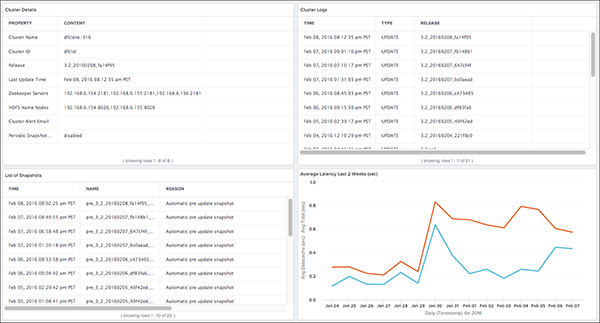The Cluster Manager section shows detailed information about a cluster including latency over time, snapshot status, installed release, node functions, and logs.

Only the Average Latency Last 2 Weeks (sec) panel contains a standard ThoughtSpot visualization. The other visualizations rely on internal queries that are not accessible. You can, however, Present or Copy link on them.
Cluster Details
The fields on this visualization have the following meaning:
| Field | Description |
|---|---|
| Cluster Name | The name of the cluster defined at installation time. |
| Cluster ID | The ID of the cluster set at installation time. |
| Last Update Time | Last time the cluster was updated. |
| Release | Version of the current release. |
| Zookeeper Servers | IP addresses of the Zookeeper servers. |
| HDFS Name Nodes | Control nodes for Hadoop Distributed File System (HDFS). |
Cluster Logs
The fields on this visualization have the following meaning:
| Field | Description |
|---|---|
| Time | A timestamp indicating when an action occurred. |
| Type | Type of action. |
| Release | Identifies the full release number. |
You can also use the tscli logs command to review log data from your cluster.
List of Snapshots
This visualization shows the snapshots and the backups taken on the cluster. The fields on this visualization have the following meaning:
| Field | Description |
|---|---|
| Time | A timestamp indicating when a snapshot or backup happened occurred. |
| Name | Name of the snapshot file. These files are stored in the `/usr/local/scaligent/backup` directory on your cluster. |
| Reason | Identifies the reason the snapshot/backup was created. You should see several period snapshots if your cluster is configured properly. You may also see evidence here of manual backups. For example, you should be sure your cluster is backed up before major events such as upgrades. Contact ThoughtSpot Support if you don't see evidence your cluster is periodically creating snapshots. |
| Size | Size of the backup in gigabytes. |
Average Latency Last 2 Weeks (sec)
This visualization relies on the TS: BI Server worksheet to display the
average database latency over the last 15 days. The database latency measures how long it takes for a search to return data from ThoughtSpot - this does not include the time taken to send the answer back to the client, it measures internal processing time. You can use the visualization
menu to drill down to its underlying query:
average datacache (sec)
average total (sec)
daily
last 15 days
for database latency (us) > 0